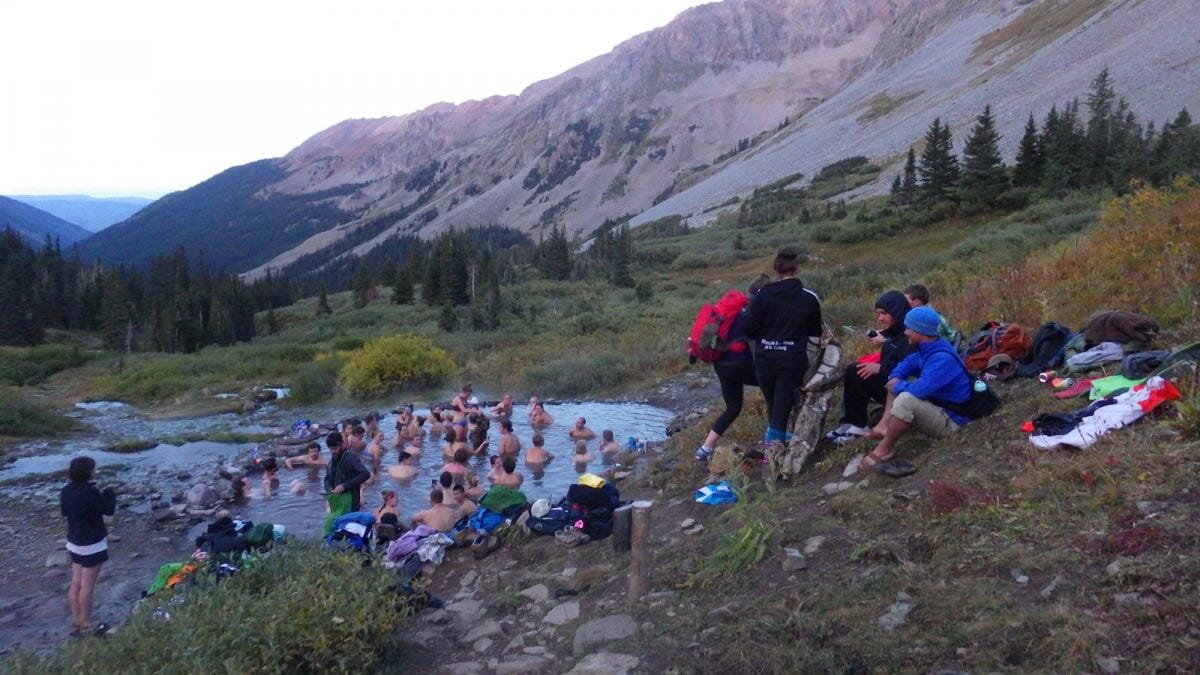News & Updates
Soaking in Colorado’s Conundrum Hot Springs


Aspen, CO: This week we visited Conundrum Hot Springs in the Maroon Bells-Snowmass Wilderness of Colorado for a Hot Spots Week aimed to provide visitor outreach and recommendations toward protecting this unique resource.
The issues at Conundrum Hot Springs are the same issues we're seeing in lots of areas with high visitation. Some of the main concerns include human waste, bear interactions, and the creation of a new permitting system effective April 18, 2018 in the area because of resource damage and impact to experiencing designated Wilderness.
The Forest Service is doing a great job with visitor education — for example, bear canister compliance has dramatically increased. In 2014, there were 30 bear interactions at Conundrum Hot Springs and after the bear canister requirement that number dropped to near 0. In our interactions on the trail, compared with outreach last year, people were more knowledgeable about the requirement and did have a bear canister with them. Leave No Trace's recommendations have focused on greater outreach to community retailers that sell bear canisters to help them to educate visitors and customers about why and how to use bear canisters.
We've also recommended resources that can be better available online when people are searching for Conundrum Hot Springs, as well as better trailhead signage as to what constitutes a bear canister vs. just a cooler or Ziploc bag since many people don't understand the difference. Additionally, we've trained Forest Service and Forest Conservancy Volunteers on better language that can help them educate visitors about why carrying a bear canister is important to the area.
Human waste is a tough issue — in many ways its socially unacceptable to talk about human waste, but that aversion means too many people are unaware of the associated impacts. In previous years, more than 6,000 overnight backpackers have visited Conundrum Hot Springs each summer. If you do the math, you can quickly see why dealing with human waste is an important concern for this area.
At Conundrum Hot Springs, where water quality is important to both the springs and river which runs through the valley, there are few acceptable Leave No Trace options besides packing it out. Land managers are offering WAG bags free at the trailhead in order to dismantle any cost barrier to doing the right thing. This has been a great step toward getting more people to pack out human waste, but more education needs to be done about how to use the bags and where to dispose of them. Our recommendations involve improving the signage at the trailhead about the process of using a WAG bag, as well as greater volunteer presence on weekends to show and give out to visitors.
For those who choose not to use a WAG bag, human waste must be buried in a 6-8 inch deep cat hole, located at least 200 feet (70 big steps) away from any water sources, including the hot springs or nearby creeks.
We've also given recommendations on Leave No Trace trainings for Forest Service Rangers and Forest Conservancy Volunteers, updating trailhead kiosk information, parking lot restrictions, Internet and name changes to increase search engine optimization, and group size limitations for their upcoming permit system.
The Forest Service is moving to adopt an educational model and wants to include Leave No Trace messaging to conserve the places they are federally charged with protecting. Maroon Bells-Snowmass Wilderness has seen 285% visitation increase in the last 10 years. With funding and staff limitations at the Forest Service, Leave No Trace aims to provide these agencies with recommendations, science-based effective language, and priority focus to better reach and educate visitors about their impacts in the beautiful natural area.
Short-term results are that the Forest Service feels supported and has a resource for questions about effective messaging and training. Our recommendations usually work as a catalyst to shift priorities to help the area, allowing Forest Service staff to initiate both small and large changes to the area. Long-term results are that this location would become a Leave No Trace Gold Standard Site and could be an example to other land managers and agencies of how education and regulation can work together to overcome impacts from visitors.
If you are visiting Conundrum Hot Springs, recreate responsibly by following these tips:
1. Secure your required permit.
Permits are required for overnight use at Conundrum Hot Springs. As of April 18, 2018, all overnight visitors to Conundrum Hot Springs must reserve a permit online in advance of their camping trip. These permits help ensure that the Wilderness characteristics of Conundrum Hot Springs stay intact. This permit system will help limit natural resource damage including vegetation trampling, tree cutting, illegal campfires, overcrowding, and water contamination. For more information about the permit system and to book your next backpacking trip, reserve your permit at Recreation.gov.
2. Bring Your Bear Canister
Bear Canisters, certified by the IGBC, are required in the Maroon Bells- Snowmass Wilderness. When bears become habituated to humans with food conditioning they can become aggressive. Storing food in a bear canister helps protect the bears and the people in Conundrum Valley. You can rent one in the area from the many outdoor stores for ~$6 a day.
2. Grab a Free WAG Bag and Pack Out Your Human Waste
Human waste from the 6,000 overnight visitors is cause for concern. Contaminating water sources like the Hot Spring and nearby river could be devastating. These bags are currently offered for free at the trailhead kiosk or are normally $2-$3 at an outdoor store. There is no trash can at the trailhead so be sure to carry out your bags all the way until you find a household receptacle or public waste bin.
For those who choose not to use a WAG bag, human waste must be buried in a 6-8 inch deep cat hole, located at least 200 feet (70 big steps) away from any water sources, including the hot springs or nearby creeks.
3. Camp in Designated Sites
Start your hike early to find your designated site. Starting in 2018 there will be 17 campsites that accommodate different group sizes. The group size limit is 10 to help protect the fragile resources around Conundrum Hot Springs. However, none of the designated sites accommodate 10 people, so larger groups must reserve multiple campsites.
Designated campsites help concentrate our use to areas that are already impacted to help prevent trampling of sensitive high-alpine vegetation.
4. Bring Your Backpacking Stove
There are no campfires allowed at Conundrum, with good reason. This area is in a high alpine zone where sensitive vegetation often takes 50-100 years to recover. Use a backpacking stove instead for cooking and warmth.
Enjoy Your World. Leave No Trace.
Leave No Trace's Donielle Stevens and Aaron Hussmann are part of the 2017 Subaru/Leave No Trace Traveling Trainer Program that provides free, mobile education to communities across the country. Proud partners of this program include Subaru of America, REI, Eagles Nest Outfitters, Deuter, Thule, Klean Kanteen, and Smartwool.
Let’s protect and enjoy our natural world together
Get the latest in Leave No Trace eNews in your inbox so you can stay informed and involved.
